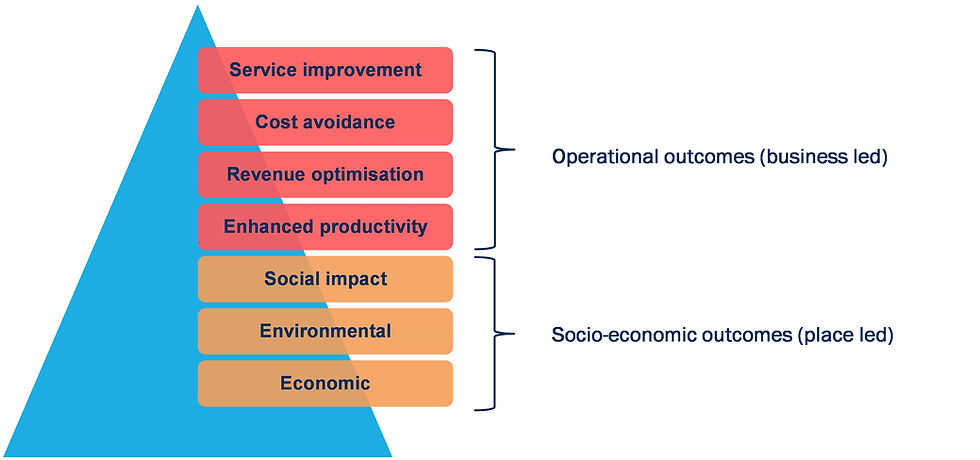ARTICLE: What is IoT and what are the benefits for local authorities?
- Iqbal Bedi
- Oct 22, 2021
- 3 min read
Updated: Jan 7, 2022
Earlier in 2021, Intelligens Consulting undertook research into the rollout and adoption of the Internet of Things (IoT) on behalf of R3-IoT, CENSIS and North. The study investigated the impact of early IoT deployments to understand how local authorities can use IoT to strengthen services while reducing costs and increasing productivity. This article, the first in a series, demystifies what we mean by IoT and reveals some of the benefits that have been discovered by our research.
IoT can help decision makers make smarter choices
So, what is IoT? Well, put simply, IoT is a collection of sensors and technologies that gather data to enable decision makers in organisations to make smarter decisions and deliver better outcomes.
Figure 1 provides a simplified technology architecture of how IoT solutions are deployed. In essence data collected by sensors is transported over a network for processing and presented to decision makers to take appropriate action, as required.
Figure 1: Simplified view of the IoT technology stack. Source: Intelligens Consulting, 2021

A sensor can be any device that collects local contextual information or data such as air quality, light, noise, humidity, temperature, pressure, motion, images, levels, proximity etc. Although many sensors serve a single function, multi-functional sensors are starting to become available and can be more cost effective in the long run where multiple data points are required.
The backhaul network is responsible for transmitting the data from the sensor to a point of aggregation for processing. The backhaul network technology used will depend upon the data being collected (i.e., size and frequency), availability of existing network connectivity, usage costs and the scope of the geographical deployment; aspects that will be discussed in a future article in this series.
The data set once received is processed and then presented in a manner typically through a specific application to decision makers.
IoT frees up valuable resources to focus on tasks of high significance
IoT is currently being deployed in low complexity situations which frees up valuable people resources to undertake more complex tasks. Examples of early use cases and the key benefits derived are shown in the table in Figure 2.
Figure 2: Summary of use cases and key benefits. Source: Intelligens Consulting, 2021

Many of the use cases mentioned above are designed for ‘low-complexity and low-intelligence’ tasks. For example, undertaking visual inspections of dampness, faulty streetlights and visitor numbers are simple tasks but time consuming for council officers to undertake. By using sensors, officer time can be freed up to focus on pertinent council priorities.
The complexity of use cases is likely to evolve over time with the introduction of Artificial Intelligence (AI) and as better processing capabilities and analytics software become available. For example, it is conceivable that AI algorithms could be trained to analyse thousands of hours of video footage taken by council vehicles to spot potholes thereby optimising maintenance schedules and preventing insurance claims. This would be far more effective than teams of people analysing video footage.
IoT can achieve operational benefits and socio-economic outcomes
The above use cases demonstrate that IoT can deliver tangible benefits. These benefits can be categorised into business led operational outcomes and place led socio-economic outcomes as shown in see Figure 3.
Figure 3: Breakdown of key benefits. Source: Intelligens Consulting, 2021

Business led operational outcomes refer to the benefits derived from IoT to local authorities. For example, the social housing use case delivered cost savings while the waste pilot and street lighting use cases delivered better workforce productivity. These are all positive outcomes for the local authority.
Place-led socio-economic outcomes refer to the benefits delivered to society and places. For example, the social housing use case could determine households at risk of fuel poverty while the street lighting use case could help to improve safety and reduce crimes. These are al benefits derived by communities, citizens and businesses.
It is important that, when embarking upon IoT projects, local authorities are aware of the outcomes they are looking to achieve so that they can be measured and quantified to determine if the IoT project is successful.
Intelligens Consulting's team of technology, strategy, economic, procurement and finance experts can help local authorities to deliver their smart and connected place ambitions. In our next article we will explain how to make financial business case stack up for IoT and how to determine the IoT return on investment.
Please contact us should you wish to learn more about anything discussed in this article.




Comments